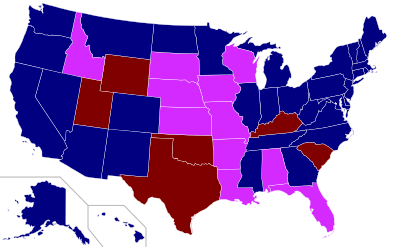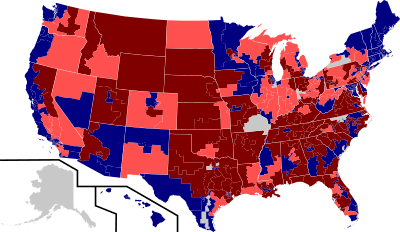Violence Against Women Act facts for kids
 |
|
| Long title | An Act to Control and Prevent Crime |
|---|---|
| Acronyms (colloquial) | VAWA |
| Enacted by | the 103rd United States Congress |
| Citations | |
| Public law | Pub.L. 103-322 |
| Statutes at Large | 108 Stat. 1796 |
| Codification | |
| Titles amended | 42 U.S.C. |
| U.S.C. sections created | 42 U.S.C. ch. 136 (originally expired on February 15, 2019, reauthorized on March 15, 2022) |
| Legislative history | |
|
|
| United States Supreme Court cases | |
The Violence Against Women Act of 1994 (VAWA) is a U.S. federal law. President Bill Clinton signed it on September 13, 1994. This law provided $1.6 billion to help investigate and prosecute violent crimes against women. It also made sure victims received money from those found guilty. The Act created the Office on Violence Against Women within the U.S. Department of Justice.
Representative Jack Brooks introduced the bill in 1994. Many groups supported it. The Act passed both parts of the U.S. Congress with support from both major political parties. However, in 2000, the U.S. Supreme Court said one part of the law went too far. This part had allowed women to sue accused people in federal court.
VAWA was renewed by Congress in 2000 and again in 2005. In 2012, some lawmakers did not want to renew it. They disagreed with extending protections to same-sex couples and to immigrants who were victims of abuse. After a long debate, VAWA was renewed in 2013. The Act expired in 2018 and again in 2019 due to government shutdowns. It was finally renewed on March 15, 2022, by President Joe Biden.
Contents
Why VAWA Was Created
In 1993, important meetings around the world agreed that domestic violence is a serious public health and human rights issue. The Violence Against Women Act was created because many people worked hard to make it happen in the late 1980s and early 1990s.
One big success of VAWA is how it helps different groups work together. Courts, police, lawyers, and victim support services now cooperate. This teamwork helps victims of domestic violence and stalking. VAWA also supports local groups that help end violence, especially those that offer services in different languages or for specific cultures. It also helps Native American women who experience violence.
The U.S. Congress has provided money for many programs under VAWA. These programs are managed by the Office on Violence Against Women. Some of these programs include:
- STOP Grants (money for states)
- Help with housing for victims
- Grants to encourage arrests and enforce protection orders
- Training for courts
- Research on violence against Native American women
- Help for victims in rural areas
- Legal help for victims
- Programs for disabled victims
- Grants to prevent violence on college campuses
Discussions and Legal Challenges
The American Civil Liberties Union (ACLU) first had some concerns about the Act. They worried about certain parts, like increased penalties. However, by 2005, the ACLU strongly supported renewing VAWA. They said it had greatly improved how law enforcement deals with violence against women. They also noted it provided important services for women in abusive situations.
Some people did not support the bill. They argued that the Act created a climate where all men were seen as violent. They also said it led to false accusations. Others believed the Act focused too much on women and did not equally help male victims.
In 2000, the Supreme Court of the United States ruled that one part of VAWA was unconstitutional. This ruling only affected the part that allowed victims to sue in federal court. Other parts of the law, like funding for programs, were not affected.
In 2005, when VAWA was renewed, it defined "Underserved Populations." This included people who are hard to reach because of where they live, their race, language, or disabilities. The renewal also stopped officials from making victims take a lie detector test to continue an investigation.
The law expired in 2011. In 2012, Congress tried to renew it. Different versions of the bill were passed by the Senate and the House. The House version, supported by Republicans, wanted to reduce services for undocumented immigrants and LGBT individuals. A final bill was not agreed upon that year, so the Act's coverage ended temporarily.
Renewing the Act in 2012–2013
When a bill to renew VAWA was introduced in 2012, some lawmakers disagreed with it. They did not want to include protections for same-sex couples. They also opposed parts that helped immigrants who were victims of abuse get temporary visas. These special visas are called U visas. There are only 10,000 U visas available each year, but many more people apply. To get a U visa, immigrant women must help catch their abuser.
In April 2012, the Senate voted to renew VAWA. The House then passed its own version, which did not include protections for gay people, Native Americans on reservations, or immigrant victims. The two versions could not be agreed upon.
In 2013, there was still a debate about tribal courts. Some worried if non-tribal members would be treated fairly in these courts.
On February 12, 2013, the Senate passed an extension of VAWA by a vote of 78–22. This bill then went to the House of Representatives.
On February 28, 2013, the House passed the Senate's full version of the bill. This version included protections for all groups. The House had previously tried to pass a weaker version, but it was rejected. The renewed Act expanded federal protections to gay, lesbian, and transgender individuals, Native Americans, and immigrants.
On March 7, 2013, President Barack Obama signed the Violence Against Women Reauthorization Act of 2013.
Later Renewals
VAWA was renewed again in 2000 and 2005. President George W. Bush signed the 2005 renewal. The 2012 renewal faced opposition from some lawmakers. They did not want to extend protections to same-sex couples or to immigrants who were victims of abuse. However, VAWA was renewed in 2013 after a long legislative fight.
On September 12, 2013, Vice President Joe Biden spoke about the Act's 19th anniversary. He criticized those who tried to slow down its renewal.

The Violence Against Women Act expired on December 21, 2018, due to a government shutdown. It was temporarily renewed in January 2019 but expired again in February 2019.
On April 4, 2019, the House of Representatives passed a bill to renew VAWA. This bill included a new rule called the "boyfriend loophole." This rule would stop people convicted of domestic abuse from buying guns, even if they were not married to their victim. All Democrats and 33 Republicans voted for this bill. However, the bill was not passed by the Senate.
On March 15, 2022, President Joe Biden signed the renewal of VAWA into law. This new law did not include the "boyfriend loophole" provision.
Programs and Services
The Violence Against Women laws have created many helpful programs and services. These include:
- Programs to prevent violence in communities.
- Protections for victims who might lose their homes because of domestic violence or stalking.
- Money for services that help victims.
- Programs that meet the needs of immigrant women and women from different backgrounds.
- Programs and services for victims with disabilities.
- Legal help for survivors of domestic violence.
Restraining Orders
If a person has a protection order (also called a restraining order), VAWA helps make sure it can be used nationwide. This means if an order is given in one state, other states must enforce it as if it was given there. This is called full faith and credit.
Who VAWA Immigration Rules Cover
VAWA has special rules for immigration. These rules allow certain people who have been abused to apply for permanent residency in the U.S. They can do this if they have a close relationship with a U.S. citizen or permanent resident who abused them. The following people can get help from these rules:
- A wife or husband who was abused by their U.S. citizen or permanent resident spouse. This also covers their children under 21.
- A child who was abused by a U.S. citizen or permanent resident parent. The child or their parent can file this request.
- A parent who was abused by a U.S. citizen child who is at least 21 years old.
Help for Male Victims
Even though the Act is called the "Violence Against Women Act," it also helps male victims. The law's actual text is written to cover all genders. The law has been changed twice to make sure men can get help too. In 2005, a change was added to say that the law should not stop male victims from getting services. In 2013, another change said that groups getting money from the Act cannot treat people differently based on their sex. However, programs can be set up for specific sexes if needed for their main purpose.
Related Efforts
The White House Council on Women and Girls is a federal government group. President Barack Obama created it in connection with the Violence Against Women Act. The group's main goal is to help improve and protect the safety and well-being of women and girls in the United States.
See also
 In Spanish: Ley de Violencia contra la Mujer (Estados Unidos) para niños
In Spanish: Ley de Violencia contra la Mujer (Estados Unidos) para niños




